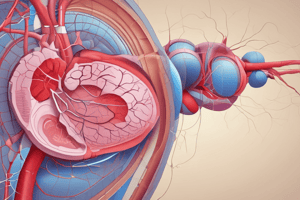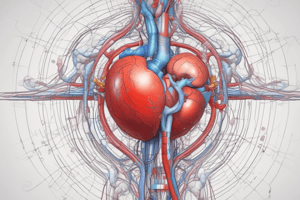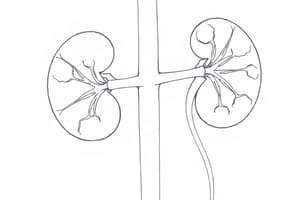Podcast
Questions and Answers
A patient presents with hypertension and hypokalemia. Which adrenal condition is most likely the cause?
A patient presents with hypertension and hypokalemia. Which adrenal condition is most likely the cause?
- Addison's Disease
- Adrenal Insufficiency
- Conn's Syndrome (correct)
- Adrenal Fatigue
Why can excess cortisol, as seen in Cushing's Syndrome, lead to hypertension?
Why can excess cortisol, as seen in Cushing's Syndrome, lead to hypertension?
- Cortisol directly stimulates the release of renin from the kidneys.
- Cortisol increases the sensitivity of alpha-1 receptors to catecholamines.
- Cortisol inhibits the production of nitric oxide, a vasodilator.
- In high concentrations, cortisol can act on aldosterone receptors, leading to sodium and water retention. (correct)
Why is it important to treat secondary hypertension by addressing the underlying cause?
Why is it important to treat secondary hypertension by addressing the underlying cause?
- Treating the hypertension directly will mask the symptoms of the underlying condition.
- The underlying cause may lead to other complications if left untreated. (correct)
- Treating the underlying cause is cheaper than managing the hypertension directly.
- Essential hypertension is always more severe than secondary hypertension.
A patient is prescribed a thiazide diuretic for hypertension. What potential electrolyte imbalance should the healthcare provider monitor for?
A patient is prescribed a thiazide diuretic for hypertension. What potential electrolyte imbalance should the healthcare provider monitor for?
Which of the following mechanisms explains how beta-blockers lower blood pressure?
Which of the following mechanisms explains how beta-blockers lower blood pressure?
What is the primary mechanism by which the baroreceptor reflex reduces blood pressure?
What is the primary mechanism by which the baroreceptor reflex reduces blood pressure?
Which of the following neurohormonal factors primarily controls blood pressure by influencing sodium balance and extracellular fluid (ECF) volume?
Which of the following neurohormonal factors primarily controls blood pressure by influencing sodium balance and extracellular fluid (ECF) volume?
A significant drop in blood pressure (5-10%) is detected by low-pressure baroreceptors. How does this affect ADH and ANP secretion?
A significant drop in blood pressure (5-10%) is detected by low-pressure baroreceptors. How does this affect ADH and ANP secretion?
What is the effect of increased sympathetic nerve activity on blood vessels, and which receptor mediates this effect?
What is the effect of increased sympathetic nerve activity on blood vessels, and which receptor mediates this effect?
After standing for several hours, a patient's blood pressure drops. Which mechanism will initially be activated to restore blood pressure?
After standing for several hours, a patient's blood pressure drops. Which mechanism will initially be activated to restore blood pressure?
A patient with chronic hypertension has a baroreceptor firing threshold that has reset to a higher pressure. What is the implication of this reset threshold?
A patient with chronic hypertension has a baroreceptor firing threshold that has reset to a higher pressure. What is the implication of this reset threshold?
A person experiences a sudden drop in blood pressure. How does the body respond via sympathetic nerve activity and ADH secretion to counteract this?
A person experiences a sudden drop in blood pressure. How does the body respond via sympathetic nerve activity and ADH secretion to counteract this?
Which of the following is NOT a primary mechanism used by the body to regulate blood pressure?
Which of the following is NOT a primary mechanism used by the body to regulate blood pressure?
Which effect would result from the administration of a drug that selectively blocks β1-adrenoceptors in the kidneys?
Which effect would result from the administration of a drug that selectively blocks β1-adrenoceptors in the kidneys?
How does Atrial Natriuretic Peptide (ANP) counteract the effects of increased blood pressure on sodium excretion?
How does Atrial Natriuretic Peptide (ANP) counteract the effects of increased blood pressure on sodium excretion?
How does ADH contribute to the formation of concentrated urine in the collecting duct?
How does ADH contribute to the formation of concentrated urine in the collecting duct?
What is the consequence of inhibiting the Na+/K+/Cl- co-transporter in the thick ascending limb of the loop of Henle?
What is the consequence of inhibiting the Na+/K+/Cl- co-transporter in the thick ascending limb of the loop of Henle?
What compensatory mechanism is triggered by decreased NaCl concentration sensed by the macula densa cells?
What compensatory mechanism is triggered by decreased NaCl concentration sensed by the macula densa cells?
How do locally acting prostaglandins, such as PGE2, protect the kidneys from excessive vasoconstriction?
How do locally acting prostaglandins, such as PGE2, protect the kidneys from excessive vasoconstriction?
What is the likely consequence of administering NSAIDs to a patient with compromised renal perfusion?
What is the likely consequence of administering NSAIDs to a patient with compromised renal perfusion?
A patient presents with severe hypovolemia. Which of the following hormonal responses would be expected to help restore blood volume?
A patient presents with severe hypovolemia. Which of the following hormonal responses would be expected to help restore blood volume?
Which of the following physiological responses is NOT a direct action of Angiotensin II?
Which of the following physiological responses is NOT a direct action of Angiotensin II?
A patient with hypertension is prescribed an AT1 receptor antagonist. Which of the following is the primary mechanism by which this medication lowers blood pressure?
A patient with hypertension is prescribed an AT1 receptor antagonist. Which of the following is the primary mechanism by which this medication lowers blood pressure?
Spironolactone is prescribed to a patient to manage their hypertension. How does this medication contribute to lowering blood pressure?
Spironolactone is prescribed to a patient to manage their hypertension. How does this medication contribute to lowering blood pressure?
A patient is diagnosed with renovascular disease due to occlusion of the renal artery. How does this condition lead to secondary hypertension?
A patient is diagnosed with renovascular disease due to occlusion of the renal artery. How does this condition lead to secondary hypertension?
Which of the causes listed below is LEAST likely to result in secondary hypertension?
Which of the causes listed below is LEAST likely to result in secondary hypertension?
How does Angiotensin II contribute to increased myocardial demand and potentially lead to ischemic heart disease?
How does Angiotensin II contribute to increased myocardial demand and potentially lead to ischemic heart disease?
What is the expected effect on blood pressure following the administration of a drug that inhibits the synthesis of aldosterone?
What is the expected effect on blood pressure following the administration of a drug that inhibits the synthesis of aldosterone?
A researcher is studying the effects of Angiotensin II on bradykinin. What effect of Angiotensin II on bradykinin would the researcher expect to find?
A researcher is studying the effects of Angiotensin II on bradykinin. What effect of Angiotensin II on bradykinin would the researcher expect to find?
Flashcards
Conn’s Syndrome
Conn’s Syndrome
Aldosterone-secreting adenoma causing hypertension and hypokalaemia.
Cushing’s Syndrome
Cushing’s Syndrome
Excess cortisol causing Na+ and water retention, leading to hypertension.
ACE Inhibitors
ACE Inhibitors
Medications that prevent production of Angiotensin II, lowering blood pressure.
Thiazide Diuretics
Thiazide Diuretics
Signup and view all the flashcards
Non-pharmacological hypertension treatment
Non-pharmacological hypertension treatment
Signup and view all the flashcards
Blood Pressure Regulation
Blood Pressure Regulation
Signup and view all the flashcards
Baroreceptor Reflex
Baroreceptor Reflex
Signup and view all the flashcards
Short-term Regulation
Short-term Regulation
Signup and view all the flashcards
Renin-Angiotensin-Aldosterone System (RAAS)
Renin-Angiotensin-Aldosterone System (RAAS)
Signup and view all the flashcards
Sympathetic Nervous System
Sympathetic Nervous System
Signup and view all the flashcards
Antidiuretic Hormone (ADH)
Antidiuretic Hormone (ADH)
Signup and view all the flashcards
Atrial Natriuretic Peptide (ANP)
Atrial Natriuretic Peptide (ANP)
Signup and view all the flashcards
Hypertension Types
Hypertension Types
Signup and view all the flashcards
Angiotensin II
Angiotensin II
Signup and view all the flashcards
AT1 receptor
AT1 receptor
Signup and view all the flashcards
Vasoconstriction
Vasoconstriction
Signup and view all the flashcards
Aldosterone
Aldosterone
Signup and view all the flashcards
Essential hypertension
Essential hypertension
Signup and view all the flashcards
Secondary hypertension
Secondary hypertension
Signup and view all the flashcards
Renovascular disease
Renovascular disease
Signup and view all the flashcards
β1-adrenoceptors
β1-adrenoceptors
Signup and view all the flashcards
Decreased GFR
Decreased GFR
Signup and view all the flashcards
Actions of ADH
Actions of ADH
Signup and view all the flashcards
Prostaglandins
Prostaglandins
Signup and view all the flashcards
Effects of NSAIDs
Effects of NSAIDs
Signup and view all the flashcards
Renin-angiotensin system
Renin-angiotensin system
Signup and view all the flashcards
Study Notes
Blood Pressure, Renal Control, and Hypertension
- Blood pressure regulation involves both short-term and long-term mechanisms.
- Short-term regulation is primarily controlled by the baroreceptor reflex
- Baroreceptors in the carotid sinus and aortic arch detect changes in arterial pressure.
- Increased pressure stretches these receptors, triggering signals to the medulla oblongata.
- Signals are sent through the glossopharyngeal and vagus nerves and affect the heart which reduces heart rate and cardiac output, it also causes vasodilation in the blood vessels. Reducing total peripheral resistance (TPR).
- This quick response helps maintain homeostasis but does not control sustained increases in blood pressure.
- Long-term regulation of blood pressure involves several neurohormonal factors.
- The renin-angiotensin-aldosterone system, sympathetic nervous system, antidiuretic hormone (ADH), and atrial natriuretic peptide (ANP) play crucial roles
Objectives
- Understand the roles of various body systems in controlling blood pressure.
- Know the function of the sympathetic nervous system, renin-angiotensin-aldosterone (RAA) system, ADH, and ANP in blood pressure regulation.
- Define and understand different types of hypertension.
- Identify the primary groups of drugs used to treat hypertension, and understand their mechanism of action.
Neurohormonal Factors
- Four neurohormonal factors regulate blood pressure: renin-angiotensin-aldosterone system, sympathetic nervous system, ADH, and ANP.
- These factors interact to control sodium balance and extracellular fluid (ECF) volume.
Baroreceptor Reflex
- The baroreceptor reflex quickly responds to acute blood pressure changes.
- A 5–10% drop in blood pressure triggers low-pressure baroreceptors in the heart and lungs to signal the medulla, resulting in ADH secretion, lowered ANP release, and sympathetic nerve outflow.
- A 5–150% change in blood pressure triggers signals through vagus and glossopharyngeal nerves, decreasing sympathetic nerve activity and ADH secretion.
Sympathetic Nervous System
- The sympathetic nervous system plays a role in long-term pressure regulation.
- Vasoconstriction by α1-adrenoceptors, increased heart rate and contractility by β1-adrenoceptors, decreased renal blood flow, reduced glomerular filtration rate (GFR), and sodium excretion, and increased renin release from juxtaglomerular cells are effects of this system.
- Increased levels of angiotensin II and aldosterone are produced.
Antidiuretic Hormone (ADH)
- ADH's actions include increasing aquaporin presence in the collecting duct of the kidneys, increasing water reabsorption, and producing concentrated urine.
- Its release is stimulated by increases in plasma osmolarity or hypovolemia. It also causes vasoconstriction reducing losses and maintaining the blood volume
Atrial Natriuretic Peptide (ANP)
- ANP acts opposite to other regulators, promoting sodium excretion.
- Synthesised in atrial myocytes.
- Released in response to high blood pressure, leading to vasodilation of afferent arterioles and increases in Na+ loss in the urine and a reduced blood volume.
- Reduced blood pressure causes a reduced ANP release.
Prostaglandins
- Prostaglandins are vasodilators, mainly PGE2.
- They enhance glomerular filtration and reduce sodium reabsorption.
- They act as a buffer against excessive vasoconstriction by the sympathetic nervous system and the renin-angiotensin-aldosterone system (RAAS).
Non-Steroidal Anti-Inflammatory Drugs (NSAIDs)
- NSAIDs inhibit the enzymes that produce prostaglandins and therefore negatively affect the kidneys, leading to decreased blood flow and GFR and exacerbates heart failure and or hypertension.
Renin-Angiotensin System
- Reduced kidney perfusion pressure activates renin release from juxtaglomerular cells.
- Renin converts angiotensinogen to angiotensin I, then to angiotensin II by ACE.
- Angiotensin II is a potent vasoconstrictor and stimulates aldosterone release.
- Reduced NaCl concentration in the macula densa and sympathetic stimulation trigger renin release.
Angiotensin II
- Angiotensin II is a potent vasoconstrictor that increases total peripheral resistance (TPR).
- It causes vasoconstriction of afferent and efferent arterioles.
- Stimulates aldosterone release, leading to increased sodium and water reabsorption.
- It stimulates sympathetic activity, the thirst mechanism, and ADH release from the hypothalamus.
Hypertension
- Persistent high blood pressure (systolic ≥ 140 mmHg and/or diastolic ≥ 90 mmHg).
- Two main types: essential (cause unknown, 95% of cases) & secondary (known cause e.g.: Renovascular disease, chronic renal disease, hyperaldosteronism, Cushing's syndrome).
Hypertension Complications
- Increased afterload causing left ventricle hypertrophy and increased myocardial demand.
- Increased risk of angina and MI, arrhythmia, and heart failure as a result of arterial damage including atherosclerosis, weakened blood vessels, aneuryms, renal failure and retinopathy.
Treatment of Hypertension
-
ACE inhibitors: Inhibit ACE to prevent angiotensin II production.
-
Angiotensin II receptor antagonists: Block angiotensin II action.
-
Thiazide diuretics: Inhibit sodium-chloride cotransporter in distal renal tubules promoting sodium and water loss.
-
Calcium channel blockers: Reduce calcium influx into smooth muscle, causing vasodilation.
-
β-blockers: Block β1-receptors, reducing heart rate and contractility.
Studying That Suits You
Use AI to generate personalized quizzes and flashcards to suit your learning preferences.
Related Documents
Description
Explore short-term blood pressure control via the baroreceptor reflex and long-term regulation involving the renin-angiotensin-aldosterone system, sympathetic nervous system, ADH, and ANP. Understand how these neurohormonal factors maintain blood pressure homeostasis.




